Emily Dickinson, one of America’s most celebrated poets, penned numerous works that explore themes of nature, spirituality, and the human experience. Among her many poems, “A Bird came down the Walk” stands out as a captivating exploration of the relationship between humans and the natural world. In this comprehensive analysis, we will delve into the rich imagery, symbolic significance, and underlying themes of Dickinson’s timeless poem, uncovering the deeper meanings hidden within its verses.
Context and Background: Emily Dickinson’s Life and Work
Before delving into the poem itself, it’s essential to understand the context in which Emily Dickinson lived and wrote. Born in Amherst, Massachusetts, in 1830, Dickinson led a reclusive life, spending much of her time in her family’s home and garden. Despite her seclusion, Dickinson’s poetry is renowned for its vivid imagery, keen observations, and profound insights into the human condition. “A Bird came down the Walk” was first published posthumously in 1891 as part of Dickinson’s vast body of work.
An Encounter with Nature: Exploring the Poem’s Imagery
“A Bird came down the Walk” begins with a simple yet vivid description of a bird’s descent onto a garden path. Dickinson’s imagery is rich and evocative, painting a picture of the bird’s graceful movements and its interaction with its surroundings. The poet describes the bird’s “softened step” and “long uncertain” gaze, highlighting the delicate balance between the bird’s wild nature and its curiosity about the human world.
The Human Connection: Contemplating the Bird’s Encounter with the Speaker
As the poem progresses, the bird’s encounter with the speaker becomes the focal point of the narrative. The bird is initially hesitant, pausing to “look” and “quiver” before proceeding cautiously along the path. Dickinson’s language here conveys a sense of intimacy and connection between the bird and the speaker, as if the two are engaged in a silent exchange of understanding and recognition.
A Moment of Revelation: The Poem’s Climactic Moment
The climax of “A Bird came down the Walk” occurs when the bird is suddenly startled by the speaker’s presence and takes flight. Dickinson’s description of the bird’s reaction is both vivid and visceral, capturing the suddenness and intensity of the moment. The bird’s “tighter breathing” and “rustling” wings evoke a sense of tension and urgency, as if the natural world itself has been momentarily disrupted by the intrusion of human presence.
Themes and Symbolism: Nature, Freedom, and the Human Condition
At its core, “A Bird came down the Walk” explores themes of nature, freedom, and the human condition. The poem’s portrayal of the bird’s encounter with the speaker serves as a metaphor for the tension between wildness and domestication, instinct and intellect. Through the bird’s flight, Dickinson suggests that true freedom lies in embracing one’s natural instincts and resisting the constraints of society.
A Bird Came Down The Walk
Related post
Legal Grounds for Obtaining a Residence Permit in Serbia
Unlocking the Mystery of Unfertilized Duck Eggs
Discovering the Allure of the Swedish Blue
Reflecting on the Poem’s Timeless Significance
In conclusion, “A Bird came down the Walk” stands as a testament to Emily Dickinson’s poetic genius and her deep reverence for the natural world. Through vivid imagery, rich symbolism, and profound insights, Dickinson invites readers to contemplate the complexities of human existence and our relationship with the world around us. As we reflect on the poem’s timeless significance, we are reminded of the enduring power of poetry to illuminate the beauty and mystery of life, one verse at a time.



